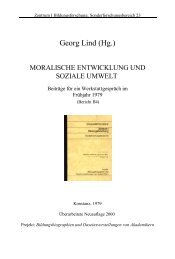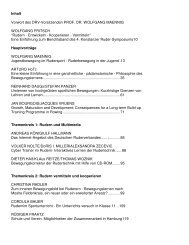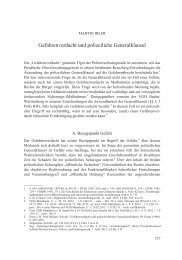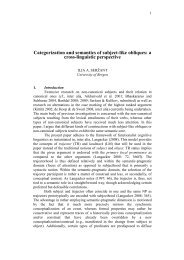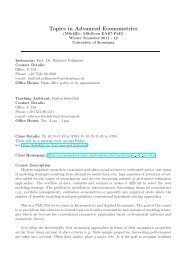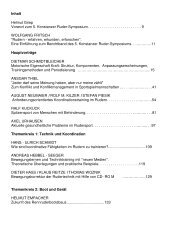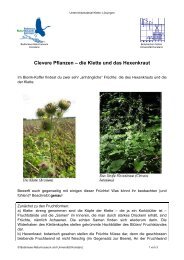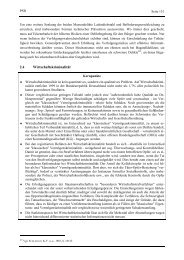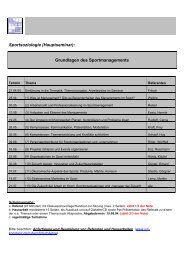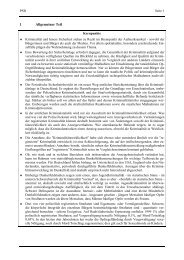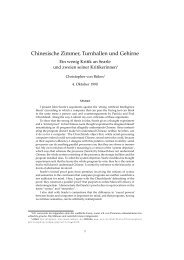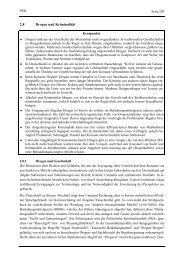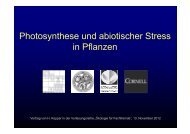Book of Abstracts Book of Abstracts - Universität Konstanz
Book of Abstracts Book of Abstracts - Universität Konstanz
Book of Abstracts Book of Abstracts - Universität Konstanz
You also want an ePaper? Increase the reach of your titles
YUMPU automatically turns print PDFs into web optimized ePapers that Google loves.
A - 3<br />
Structure, energetics, and thermodynamics <strong>of</strong> copper, nickel, and gold<br />
clusters: N = 2–150<br />
V. G. Grigoryan, D. Alamanova, and M. Springborg<br />
<strong>Universität</strong> des Saarlandes, Physikalische und Theoretische Chemie, Postfach 151150<br />
D-66041 Saarbrücken, Germany<br />
The three most stable structures <strong>of</strong> CuN, NiN, and AuN clusters with N between 2 and 150<br />
have been determined using a combination <strong>of</strong> the Embedded-Atom (EAM), the quasi-Newton,<br />
and our own [1-3] Aufbau/Abbau methods for calculations <strong>of</strong> the total energies, local and global<br />
minima, accordingly. We have employed two well-known versions <strong>of</strong> the EAM: (1) the bulk<br />
version <strong>of</strong> Daw, Baskes and Foiles and (2) the Voter-Chen version which takes into account<br />
properties <strong>of</strong> the dimer. The lower-energy structures (also for the smallest ones) <strong>of</strong> CuN and NiN<br />
clusters (structural details, symmetry and the ordering <strong>of</strong> the isomers) obtained with the two<br />
versions are almost the same. Thus our study points to the universality <strong>of</strong> the bulk embedding<br />
functions and potentials for copper and nickel at least for computations <strong>of</strong> structural properties.<br />
But the bulk EAM fails completely to describe the structures <strong>of</strong> the smallest Au clusters. Hence<br />
for the gold clusters only the Voter-Chen version <strong>of</strong> the EAM has been used. Copper and nickel<br />
grow qualitatively similarly. Generally, we find a multilayered icosahedral or layer-by-layer<br />
growth. But the cluster growth pattern between two closed-shell icosahedra is not simple. It is<br />
predominantly icosahedral with islands <strong>of</strong> fcc, tetrahedral, and decahedral growth. Further, we<br />
have observed an enhanced ability <strong>of</strong> fcc clusters to compete with icosahedral and decahedral<br />
structures in the vicinity <strong>of</strong> N=79. The truncated centered octahedron at N=79 is the first and the<br />
second lower-energy structures for Cu and Ni clusters, respectively. The derived results are<br />
detailed discussed and compared with those <strong>of</strong> available ab initio and semiempirical studies.<br />
Agreement with experimental studies is very good in many cases. The situation for gold is more<br />
complicated. We could not detect any favored structural motif. For example, Au13 is the first<br />
Mackay icosahedron, Au38 is the truncated octahedron, but all the three isomers for Au55 are<br />
low-symmetric. Our result for 38-atom gold cluster agrees with the many-body Sutton-Chen and<br />
Murrell-Mottram calculations, but it is in contradiction with the 'disordered' result <strong>of</strong> the n-body<br />
Gupta potential. Hence more studies are needed. Furthermore, we determine the full vibrational<br />
spectrum and the vibrational heat capacities (contributions from rotations are negligible) <strong>of</strong><br />
clusters for each cluster size. It is found, that the 23-atom Cu or Ni cluster (triple icosahedron)<br />
possesses the highest vibrational frequency. Further it is shown that the highest vibrational<br />
frequency is lower in the fcc and decahedral clusters and higher in the icosahedral ones. The<br />
heat-capacity plots for low temperatures show very interesting fine structures with minima at<br />
magic numbers <strong>of</strong> 13 and 55 and with a broad maximum in the vicinity <strong>of</strong> N=35.<br />
References<br />
[1] V. G. Grigoryan and M. Springborg, Phys. Chem. Chem. Phys. 3, 5125 (2001).<br />
[2] V. G. Grigoryan and M. Springborg, Chem. Phys. Lett. 375, 219 (2003).<br />
[3] V. G. Grigoryan and M. Springborg, Phys. Rev. B 70, 205415 (2004).<br />
105



